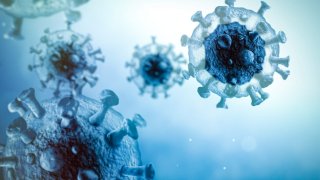
Public health officials confirmed Wednesday that there have been three cases of a new subvariant of omicron, known as the "stealth" version, recorded in San Diego County since Christmas.
Sequencing detected two cases of the BA.2 mutation — a subset of the widespread omicron variant — on Dec. 26 and a third was found Jan. 2, according to a spokeswoman for the San Diego County Health and Human Services (HHSA) agency and genomic surveillance reporting.
The county confirmed at least one San Diego County resident has tested positive for the BA.2 subvariant but said the other cases may have been detected among residents or non-residents who were tested while in the county at the time.
Get top local stories in San Diego delivered to you every morning. >Sign up for NBC San Diego's News Headlines newsletter.
The County of San Diego Health & Human Services Agency spokeswoman said on Thursday that no additional BA.2 cases were reported this week and that "no BA.2 has been detected in the wastewater surveillance so far," pointing out that the wastewater surveillance "provides more timely results and reflects a more complete picture of variant activity in the region." Genomic sequencing, which identifies individuals infected with a particular variant or subvariant, takes longer to yield results, she said, than does wastewater surveillance.
BA.2 has been detected in at least 40 countries, and California has already reported nearly a dozen cases, which prompted NBC 7 to reach out to county health officials to determine if any cases had been detected here.
Local
The new subvariant of the coronavirus has been called the "stealth" version because it can be difficult to differentiate from the former delta variant but be equally — if not more — contagious than the omicron variant.
The mutant is more common in Asia and Europe, particularly in Denmark, where 45% of COVID-19 cases last week were attributed to BA.2.
Dr. William Tseng, President of Professional Staff at Southern California Permanente Medical Group, said doctors locally are not too concerned with the subvariant.
"It's harder to determine whether, 'Is this the omicron or is this the delta variant?' That's the only thing we can't say for certain but, that being said, we've seen very little amounts of this subvariant and we're not concerned about it."
So far, the World Health Organization has not given the BA.2 variant its own classification, which is why it does not follow the Greek-letter naming convention of other "variants of concern," such as delta and omicron, but the WHO believes that investigations of BA.2 “should be prioritized."
Scientists are still looking into how infectious the subvariant is and how well vaccines protect against it. It is also unclear whether an individual who was infected by the COVID-19 omicron variant can later contract BA.2.
Why Is It Harder to Detect?
The original version of omicron had specific genetic features that allowed health officials to rapidly differentiate it from delta using a certain PCR test because of what’s known as “S gene target failure.”
BA.2 doesn't have this same genetic quirk. So on the test, BA.2 looks like delta, according to Dr. Wesley Long, a pathologist at Houston Methodist, in Texas,
“It's not that the test doesn't detect it; it's just that it doesn't look like omicron,” he said. "Don’t get the impression that ‘stealth omicron’ means we can’t detect it. All of our PCR tests can still detect it.”
What Should You Do to Protect Yourself?
Doctors advise the same precautions they have all along: Get vaccinated and follow public health guidance about wearing masks, avoiding crowds and staying home when you’re sick.
“The vaccines are still providing good defense against severe disease, hospitalization and death,” Long said. “Even if you’ve had COVID 19 before — you’ve had a natural infection — the protection from the vaccine is still stronger, longer lasting and actually ... does well for people who’ve been previously infected.”
The latest version is another reminder that the pandemic hasn't ended.
“We all wish that it was over," Long said, ”but until we get the world vaccinated, we’re going to be at risk of having new variants emerge.”
The Associated Press Health and Science Department receives support from the Howard Hughes Medical Institute’s Department of Science Education.



